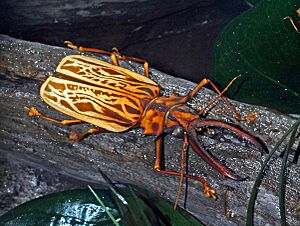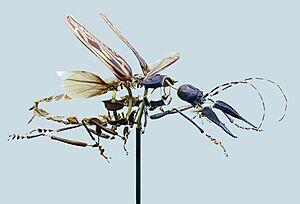Macrodontia cervicornis facts for kids
Quick facts for kids Macrodontia cervicornis |
|
|---|---|
 |
|
| Mounted specimen at the Museo Civico di Storia Naturale di Milano | |
| Conservation status | |
| Scientific classification |

The Macrodontia cervicornis, also known as the sabertooth longhorn beetle, is one of the biggest beetles in the world. It gets its name from the huge jaws that male beetles have. The name Macrodontia means "long tooth," and cervicornis means "deer antler," which perfectly describes its impressive jaws!
When we measure insects, we usually don't count their legs, jaws, or horns. But if you include its jaws, the longest sabertooth longhorn beetle ever found was 17.7 centimeters long. That's longer than some other famous giant beetles, like the Dynastes hercules (17.5 cm) or the Titanus giganteus (16.7 cm).
Life Cycle of the Sabertooth Longhorn Beetle
This amazing beetle spends most of its life as a larva. This larval stage can last for a very long time, sometimes up to 10 years! During this time, the larva grows and develops hidden away.
Once it becomes an adult beetle, its life is much shorter, probably only a few months. In this short adult phase, the beetles focus on finding a mate and laying eggs.
How New Beetles Begin
Female sabertooth longhorn beetles lay their eggs under the bark of dead or dying softwood trees. When the eggs hatch, tiny larvae emerge. These larvae then start to burrow deep into the rotting wood.
As they grow, the larvae create long tunnels, called galleries. These tunnels can be over a meter long and about 10 centimeters wide! They spend years eating the wood and growing before they are ready to change into adult beetles.
Where Do These Beetles Live?
The sabertooth longhorn beetle lives in the warm, wet rain forests of South America. You can find them in countries like Colombia, Ecuador, Peru, Bolivia, the Guianas, and Brazil. They need these forests because that's where they find the dead trees they need for their larvae to grow.


